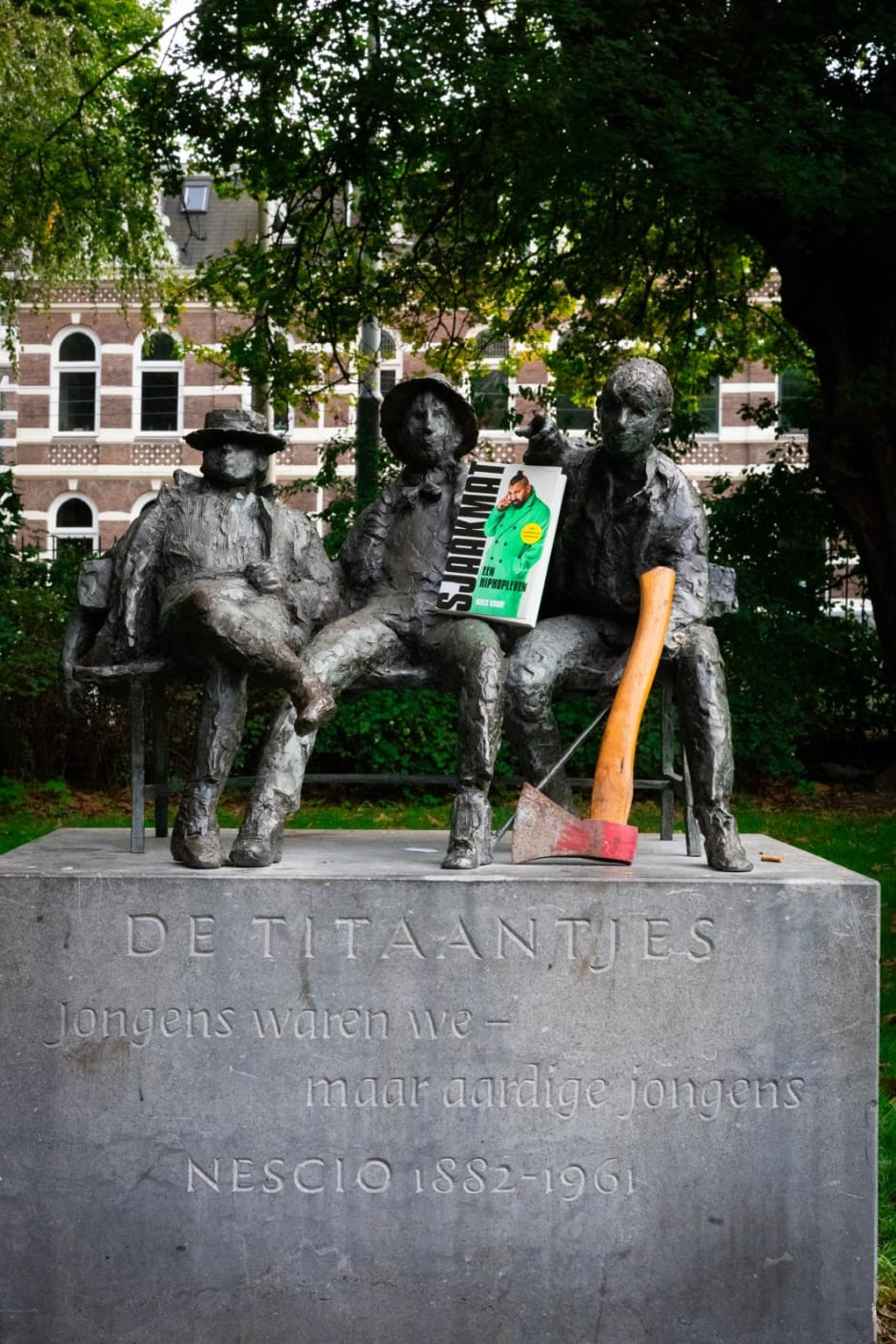
UvA law lecturer writes biography of an Amsterdam Hip-Hop legend
During their many walks together through Oosterpark and their conversations in the studio or backstage after performances, UvA law lecturer Niels Graaf was drawn into rapper Sjaak’s world. Now there is the biography Sjaakmat (Dutch only) that Graaf wrote about the Amsterdam artist. “He used to walk through Amsterdam-East carrying a hatchet.”
Why was Sjaak the right person for you to write a biography about?
“Sjaak, to me, symbolises the modern history of Dutch hip-hop. He may not be as well-known as Opgezwolle or De Jeugd van Tegenwoordig, yet he played a central role with a unique voice. He suddenly appeared and everyone was listening to his music, even the classical grammar school students at Barlaeus or Vossius. With his breakthrough hit Ik Heb Schijt he defined the year 2007. He renamed Amsterdam East The Double O and became an important figure in a cultural life that is often overlooked.”
“Sjaak is, in a way, a modern-day Nescio, the iconic writer from Amsterdam East. I just cycled through Oosterpark, where there’s a statue of Nescio’s Titaantjes, but it feels outdated now. Who still reads that? What Sjaak does today is far bigger, yet it isn’t recognised as high culture. I want to challenge that.”
So you see him as a modern literary figure?
“That’s exactly how I want to present him. Think of it as a plea for greater recognition of hip-hop as a serious cultural movement. There’s still too little of that. Hip-hop is the most popular and most streamed genre in the Netherlands, but many people still find it strange. It’s dismissed as youth culture and not taken seriously. There’s still a lot to gain there.”
Rapper Sjaak — whose real name is Mehdi Chafi — was born in 1985 in Amsterdam East. The Moroccan-Dutch rapper broke through in 2007 with the song Ik heb schijt (“I don’t care”) and went on to score hits in the following years with tracks such as Trompetisto and Stap voor Stap. He now lives with his family in Bathmen, in the province of Overijssel.
Why not write a biography about De Jeugd van Tegenwoordig or Osdorp Posse, artists who arguably helped shape Amsterdam hip-hop even more than Sjaak?
“That’s a slightly different category. I wanted to capture the world that emerged from street culture, which is more closely connected to Sjaak. I also feel that he’s been somewhat overlooked. He inspired an entire generation of new rappers through his inventive use of language and his distinctive flow. That story hasn’t been told.”
So could we call him the godfather of Amsterdam hip-hop?
“Within a certain school of Amsterdam hip-hop, yes.”
We’re sitting here at the law faculty surrounded by portraits of great constitutional scholars. Would a stately portrait of Sjaak fit among them?
“Absolutely, but ideally he should have a statue on Boerhaveplein.”
Is Sjaak still known among today’s law students?
“I’m not sure. It’s not as if I constantly told them I was writing a biography about him.”

Your fascination with Amsterdam hip-hop might be expected more from a musicologist or a Dutch literature scholar than from a law lecturer.
“Legal scholars have every right to write a rapper’s biography too. But you’re right, it’s more common among literature scholars. Still, I’d stress that we also practise textual criticism here at the law faculty. When I analyse a Supreme Court ruling, that’s a kind of puzzle. Comparing that to hip-hop lyrics, I’m still doing literary criticism. It’s all connected. Let’s call it a broad fascination with words, writing and cultural expression.”
After studying Sjaak’s lyrics so closely, which line comes to mind first?
“Generally speaking, he does remarkable things with words, making rhymes others never thought of. When the book was nearly finished I spoke with Pepijn Lanen – Faberyayo from De Jeugd van Tegenwoordig – who told me I’d left out something crucial. I’d cut a line that, according to him, captured Sjaak’s genius: ‘Stack up de vissticks.’ Pepijn said it was an analogy for wealth, stacking meaning collecting, and fish sticks symbolising money. Nobody had ever come up with that before, he said.”
“There are so many examples like that in his lyrics. He’s playful, blending gangster rap with sudden humour. ‘Guns go bang bang, Guus Meeuwis goes kedeng kedeng.’ That’s a kind of poetry many people fail to see. I want to bring that to light.”
How much of Sjaak’s background is rooted in the rougher side of Amsterdam?
“He grew up near Boerhaveplein. He really did deal in his youth and knows that world, but he’s been out of it for a long time. You can be critical of that past, but he’s left it behind and you can hear it in his music. It’s become more festive, moving away from criminality. He now lives in a small village near Deventer and earns his living legitimately. He doesn’t rap about that old life anymore.”
You open the book with lyrics from Deze Stad. Why?
“I think those lines capture both his life and the essence of Amsterdam street life. It’s a beautiful glimpse into that world. He’s long since left that behind. He loves his quiet village life now and has no desire to return. When we met in Amsterdam he’d complain about the crowds, the parking, the expats. On the square where he grew up we were now served in English because of all the gentrification. In that sense the book is also an ode to an Amsterdam that no longer exists.”
Can you still listen to his music?
“I think I’m the person in the world who’s listened to Sjaak’s music the most, and the most attentively. Sometimes I’d have to listen to a track five times in a row just to grasp everything properly. But I never get tired of it. I was listening to it just now on my bike ride to the faculty.”
What was it like working with him?
“Hilarious. We knew each other from back in Amsterdam East. The idea came about seven years ago when we bumped into each other again. He joked that I should write his biography, and it actually seemed like a great idea. Working with Sjaak was always fun. While writing the book we met often. I’d join him at shows or in the studio, talking to other artists about what makes him unique.”
The book is full of anecdotes, there’s even one about a hatchet.
“Yes, the hatchet. When he was a young man in Amsterdam East he’d walk around with one. That’s the level we’re talking about, after all you never know when you might need it. It was a rough neighbourhood then. Now Amsterdam-East is trendy and tidy, all the rough edges gone. But back then it was a tough ‘Vogelaarwijk’, groups of teenagers hanging around, the police avoiding the area. That’s changed. The hatchet was precautionary of course, but mostly a way to look tough.”
Niels Graaf, Sjaakmat. Een Hiphopleven (Prometheus, 2025). ISBN: 978 90 446 55 629. Price: €20.00


